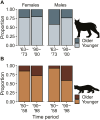Accounting for age: uncovering the nuanced drivers of mammal body-size responses to climate change
- PMID: 39434844
- PMCID: PMC11491926
- DOI: 10.1093/jmammal/gyae005
Accounting for age: uncovering the nuanced drivers of mammal body-size responses to climate change
Abstract
Shifts in mean body size coinciding with environmental change are well documented across animal species and populations, serving as a widespread and complex indicator of climate-change response. In mammal research, identifying and disentangling the potential drivers of these trends (e.g., thermoregulation, resource availability) is hindered by treating adult size as fixed, ignoring morphological changes that occur throughout life in many species. However, observed population-level size trends may reflect underlying shifts in age structure (i.e., change in the proportion of older, potentially larger individuals in the population). Here, we assessed the role of age structure by explicitly evaluating age as a contributor to temporal variation in skull size (a proxy for body size) in 2 carnivorans, Canadian Lynx (Lynx canadensis) and American Marten (Martes americana). Using a series of linear and nonlinear models, we tested age in years (determined by cementum-layer analysis) as a predictor of skull size alongside other factors previously proposed to be important drivers of body-size trends, including population density for lynx and growing season conditions for martens. In both species, age was a significant predictor of skull size indicating a rapid year-to-year increase in young adult size that diminished in later adulthood. However, temporal shifts in age structure alone did not explain the observed changes in size over time, indicating that age structure acts in concert with other as-yet unidentified factors to drive body-size change. By explicitly evaluating the role of age, we can both refine models of temporal body-size trends and gain insights into size change as a signal of underlying demographic shifts-such as age-specific survivorship-providing a more holistic understanding of how mammals are responding to climate change.
Keywords: Lynx canadensis; Martes americana; age structure; body size; climate-change response.
© The Author(s) 2024. Published by Oxford University Press on behalf of the American Society of Mammalogists.
Conflict of interest statement
None declared.
Figures




References
-
- Andersen T, Wiig O.. 1984. Growth of the skull of Norwegian lynx. Acta Theriologica 29(8):89–110. 10.4098/at.arch.84-8 - DOI
-
- Augusteyn RC. 2014. Growth of the eye lens: I. Weight accumulation in multiple species. Molecular Vision 20:410–426. https://pubmed.ncbi.nlm.nih.gov/24715758 - PMC - PubMed
-
- Bergmann C. 1847. Über die Verhältnisse der Wärmeökonomie der Thiere zu ihrer Grösse. Göttinger Studien 1:595–708.
-
- Branch CL, Pitera AM, Kozlovsky DY, Sonnenberg BR, Benedict LM, Pravosudov VV.. 2019. Elevation-related differences in the age structure of breeding birds suggest stronger selection at harsher elevations. Behavioral Ecology and Sociobiology 73(10):143. 10.1007/s00265-019-2750-4 - DOI
LinkOut - more resources
Full Text Sources

